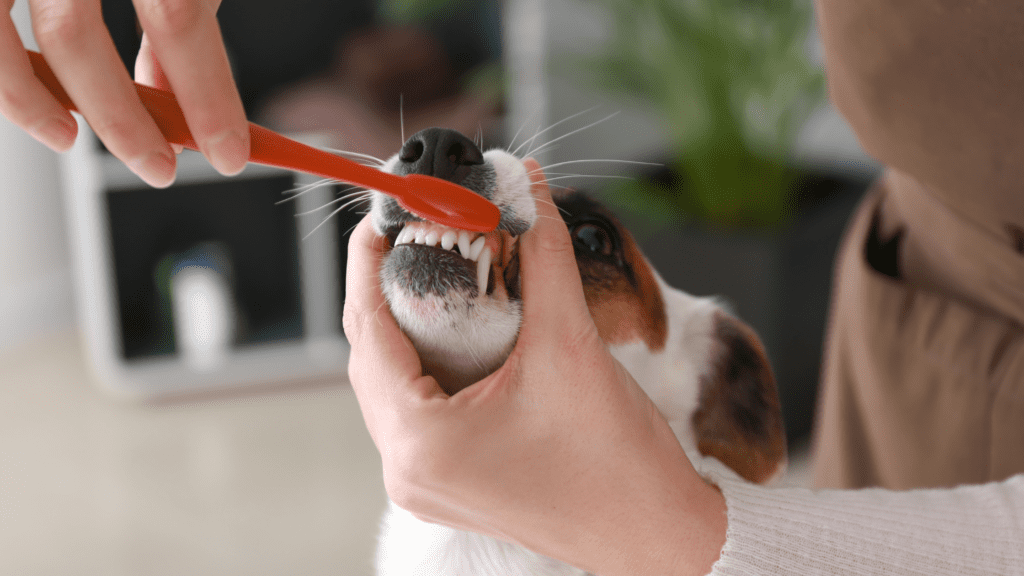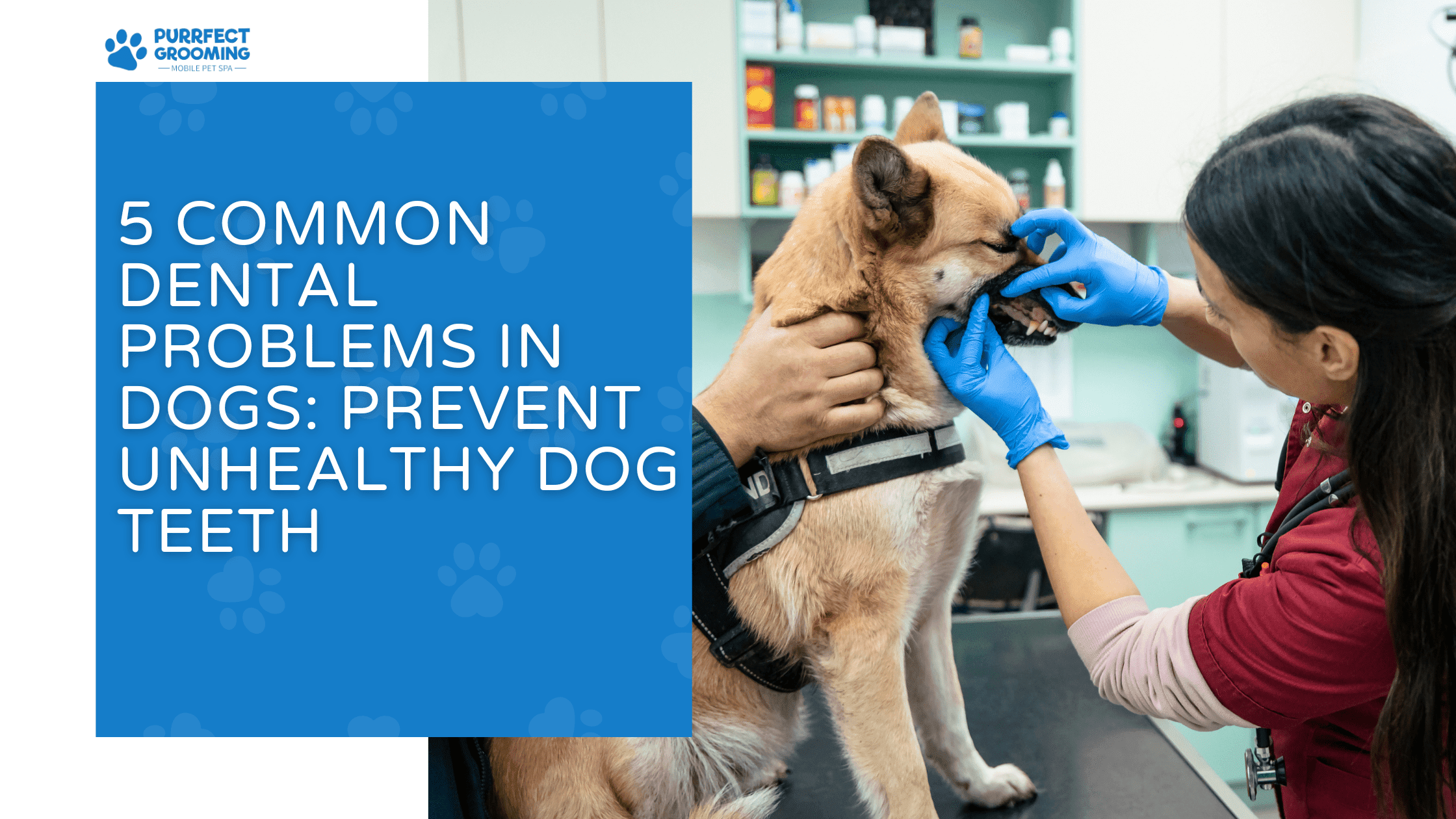5 Common Dental Problems in Dogs: Prevent Unhealthy Dog Teeth
Dogs rely on their teeth for more than just eating—they need them for playing, grooming, and more. However, unhealthy dog teeth can lead to various problems that impact not only the mouth but also overall health. According to the American Veterinary Medical Association (AVMA), over 80% of dogs show signs of dental disease by the age of three.In this guide, we will explore five common dental problems caused by unhealthy dog teeth, as well as how to spot, prevent, and treat these issues.
Why Dental Health in Dogs Is Important
Dental health is vital for your dog’s overall well-being. If left unchecked, unhealthy dog teeth can lead to pain, infections, and even life-threatening diseases.
Role of Healthy Dog Teeth in Overall Well-being
Strong, healthy teeth help dogs maintain proper nutrition, while unhealthy dog teeth can cause difficulty eating and even lead to weight loss and other issues.
Unhealthy Dog Teeth Signs to Watch For
Bad breath, red or inflamed gums, and difficulty chewing are all signs of unhealthy dog teeth. These symptoms indicate potential underlying dental issues that need attention.
1. Plaque and Tartar Buildup on Unhealthy Dog Teeth
Plaque and tartar are the primary culprits when it comes to bad dog teeth. Over time, the bacteria in plaque hardens into tartar, which is much harder to remove.
| Problem | Cause | Symptoms |
| Plaque Buildup | Bacteria from food particles | Bad breath, sticky film on teeth |
| Tartar Formation | Hardened plaque due to poor brushing | Yellow/brown deposits near gums |
What Is Plaque and How It Affects Dogs’ Teeth
Plaque forms when food particles mix with bacteria in a dog’s mouth. If not removed through regular brushing, it leads to tartar buildup and unhealthy dog teeth.
Symptoms of Tartar and Bad Dog Teeth
You’ll notice a yellow or brown buildup along the gum line. This buildup can cause inflammation and infection, leading to unhealthy dog teeth and painful gums.
2. Gum Disease (Periodontal Disease) and Bad Dog Teeth
Gum disease is a severe issue stemming from bad dog teeth, affecting the tissues and bones that hold the teeth in place. It’s more common than you might think, affecting many dogs over the age of three.
| Stage of Gum Disease | Description | Symptoms |
| Gingivitis | Early stage with gum inflammation | Red, swollen, or bleeding gums |
| Periodontal Disease | Advanced stage where tooth-supporting structures weaken | Loose teeth, difficulty chewing, pain |
Stages of Gum Disease in Dogs
Gum disease starts as gingivitis (inflamed gums) but can progress to periodontal disease, which leads to loose or lost teeth due to unhealthy dog teeth.
How to Prevent Periodontal Disease in Dogs
Regular dental care, such as brushing and professional cleanings, can help prevent bad dog teeth and gum disease from progressing to more severe stages.
Link Between Bad Dog Teeth and Serious Health Risks
Unhealthy dog teeth can lead to bacterial infections that spread to other organs like the heart and kidneys, posing significant risks to your dog’s overall health.
3. Tooth Fractures in Dogs with Bad Dog Teeth
Fractured teeth are common in dogs, especially in those that chew on hard objects. A tooth fracture can cause pain and infection, worsening the issue of bad dog teeth.
Causes of Broken or Fractured Dogs’ Teeth
Dogs can fracture their teeth on hard bones, toys, or even from accidental trauma. Bad dog teeth are more prone to breaking since the enamel is already weakened.
How to Recognize Tooth Fractures in Dogs
You might see a cracked or discolored tooth. Other signs of fractured or bad dog teeth include excessive drooling and refusal to eat hard food.
Treatment Options for Fractured Teeth
Depending on the severity, fractured teeth may need extraction or repair. Fractures in dogs with bad dog teeth may require more intensive treatment due to infection risks.
You May Also Like : How Often To Trim Dogs Nails
4. Tooth Root Abscess and Bad Dog Teeth
A tooth root abscess is an infection at the root of a dog’s tooth, usually caused by an untreated fracture or severe gum disease in bad dog teeth. This is a painful condition that requires immediate attention.
Causes and Risks of Abscess in Dogs’ Teeth
Abscesses form when bacteria enter through cracks in unhealthy dog teeth. This can happen from fractures, cavities, or advanced gum disease.
Symptoms and Diagnosis of Tooth Root Abscess
Swelling around the eye or face, fever, and lack of appetite are common signs. Dogs with bad dog teeth are especially prone to developing abscesses.
Prevention and Treatment of Tooth Abscess
Regular dental checkups can catch abscesses early, but advanced cases may require antibiotics or tooth extraction, especially in dogs with bad dog teeth.

5. Tooth Decay (Cavities) and Unhealthy Dog Teeth
Cavities are less common in dogs but can still occur. Poor dental hygiene leads to the decay of unhealthy dog teeth, creating cavities that cause pain and infection.
| Causes of Tooth Decay | Prevention | Symptoms |
| Bacterial buildup | Regular brushing, dental treats | Visible holes, bad breath |
| Sugary treats | Healthy diet, professional cleanings | Pain while eating, sensitivity |
What Causes Tooth Decay in Dogs
Cavities form when bacteria in the mouth produce acids that eat away at tooth enamel. Bad dog teeth are particularly susceptible to cavities due to weak enamel.
Signs of Decayed Dog Teeth
Dogs with decayed teeth may have visible holes in their teeth, bad breath, and pain while eating. These are signs of unhealthy dog teeth that require immediate attention.
Treatment and Prevention of Cavities in Dogs
Treating cavities in unhealthy dog teeth typically involves fillings or extractions. Brushing your dog’s teeth and providing dental chews can help prevent cavities from forming.
How to Maintain Good Dental Hygiene in Dogs with Unhealthy Teeth
Brushing Dogs’ Teeth: Tips and Techniques
Regular brushing is essential for maintaining healthy teeth and preventing unhealthy dog teeth. Use a toothbrush designed for dogs and a dog-friendly toothpaste.
Healthy Dog Treats for Cleaner Teeth
Dental treats can help clean your dog’s teeth and reduce plaque. Look for treats specifically designed to improve the health of bad dog teeth.
Regular Dental Check-ups and Professional Cleanings
Annual dental cleanings are important, especially for dogs with a history of bad dog teeth. Professional cleanings can reach areas that brushing at home may miss.
You May Also Like : 10 Most Common Dog Diseases
The Impact of Unhealthy Dog Teeth on General Health
How Bad Dog Teeth Can Lead to Other Health Issues
Unhealthy dog teeth can lead to infections that spread throughout the body, causing heart disease, kidney problems, and more.
Connection Between Dental Health and Heart Disease in Dogs
There is a strong link between gum disease and heart disease in dogs. Bacteria from bad dog teeth can enter the bloodstream and cause damage to the heart.
Conclusion
Maintaining your dog’s dental health is crucial for their overall well-being. Unhealthy dog teeth can cause discomfort, infections, and even lead to more serious health conditions. By keeping an eye on common dental issues like plaque buildup, gum disease, fractures, abscesses, and tooth decay, you can ensure your dog enjoys a healthy, pain-free life.
Pro Tip: Regularly brushing your dog’s teeth with pet-safe toothpaste and scheduling annual dental check-ups with your veterinarian can significantly reduce the risk of these issues.
FAQs
1. How often should I brush my dog’s teeth?
It’s recommended to brush your dog’s teeth at least 2-3 times a week, but daily brushing can help prevent unhealthy dog teeth and more serious dental problems.
2. Are there any safe home remedies for bad dog teeth?
Yes, you can use dental rinses or water additives to help keep bad dog teeth clean, but always consult your vet before trying any new products.
3. Can dogs live with untreated dental problems?
Untreated dental problems can lead to infections and other serious health issues, so it’s crucial to address unhealthy dog teeth as soon as possible.
4. What is the best diet to maintain healthy dog teeth?
A diet of crunchy kibble and dental chews can help reduce plaque and tartar buildup on your dog’s teeth, preventing them from becoming unhealthy.
5. How do I know if my dog has a dental problem?
Signs of unhealthy dog teeth include bad breath, red or swollen gums, excessive drooling, and difficulty eating. If you notice any of these signs, consult your vet.
